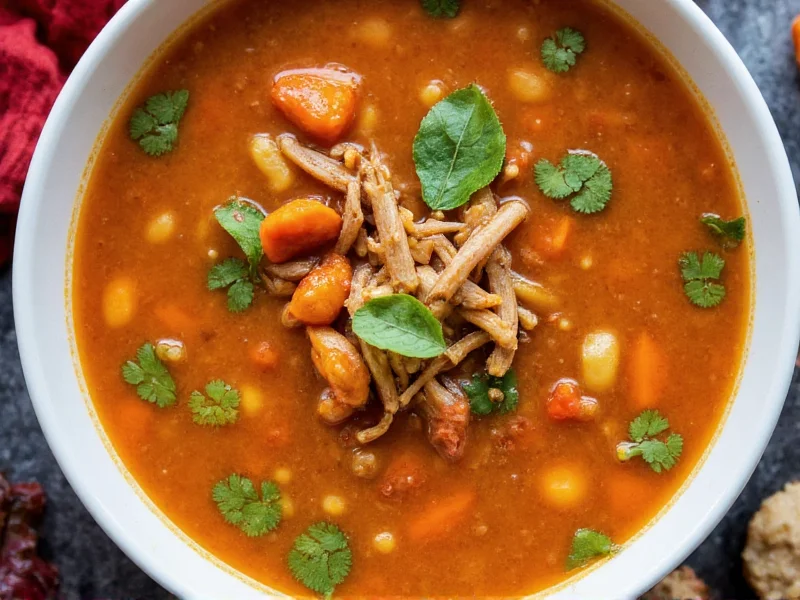Brothy soups represent one of the most fundamental and universally cherished culinary traditions across cultures. These light yet flavorful preparations offer more than just comfort—they provide a foundation for countless global dishes while delivering significant nutritional advantages. Understanding what makes a soup truly "brothy" separates exceptional culinary creations from ordinary preparations.
What Defines a True Brothy Soup
The essence of brothy soups lies in their clarity and depth of flavor. Unlike chowders or bisques, brothy soups maintain a clear, unthickened liquid base where ingredients remain distinct rather than blended. Professional chefs achieve this through careful temperature control—simmering ingredients gently rather than boiling vigorously, which keeps the broth clear and prevents cloudiness.
Authentic brothy soups develop complex flavors through extended cooking times. Traditional bone broths often simmer for 12-24 hours, allowing collagen to break down into gelatin while extracting minerals from bones. Vegetable-based broths typically require less time but still benefit from slow extraction of flavors from aromatic vegetables like onions, carrots, and celery.
Global Variations of Brothy Soups
Cultures worldwide have perfected their own distinctive brothy soup traditions, each reflecting local ingredients and culinary philosophies. These preparations demonstrate how a simple concept adapts beautifully across different culinary landscapes.
| Soup Type | Origin | Key Ingredients | Traditional Purpose |
|---|---|---|---|
| Miso Soup | Japan | Dashi broth, miso paste, tofu, seaweed | Daily breakfast staple with probiotic benefits |
| Caldo | Latin America | Chicken broth, vegetables, herbs | Family meal for comfort and nourishment |
| Pho | Vietnam | Beef or chicken broth, rice noodles, herbs | National dish with medicinal properties |
| Matzo Ball Soup | Jewish tradition | Chicken broth, matzo balls, vegetables | "Jewish penicillin" for healing and comfort |
Nutritional Advantages of Brothy Soups
Scientific research increasingly validates what traditional cultures have known for centuries—the substantial health benefits of brothy soups. These light preparations offer exceptional nutritional density without excessive calories, making them valuable components of balanced diets.
Gelatin extracted during long simmering provides amino acids like glycine and proline that support gut lining integrity and reduce inflammation. Studies published in the Journal of Agricultural and Food Chemistry confirm that properly prepared bone broths contain significant amounts of minerals including calcium, magnesium, and phosphorus in highly bioavailable forms.
For those following specific dietary patterns, brothy soups offer versatile solutions. They naturally align with paleo, keto, and gluten-free approaches while providing hydration and electrolytes—particularly valuable during illness or recovery. The low-calorie nature of clear broths makes them excellent for weight management without sacrificing satisfaction.
Mastering Broth Preparation Techniques
Creating exceptional brothy soups requires understanding several critical techniques that transform ordinary preparations into extraordinary culinary experiences. Temperature control represents the most crucial factor—maintaining a gentle simmer rather than a rolling boil prevents emulsification of fats that would cloud the broth.
Skimming impurities during the initial heating phase significantly improves clarity and flavor. As the broth heats, proteins coagulate and rise to the surface as scum—carefully removing this with a fine mesh skimmer results in a cleaner-tasting final product. For vegetable broths, roasting vegetables before simmering develops deeper caramelized flavors through the Maillard reaction.
Acidity plays a surprisingly important role in extraction. Adding a small amount of vinegar or wine to bone broths helps draw minerals from bones into the liquid. However, balance is essential—too much acid overwhelms delicate flavors. The optimal ratio typically ranges from 1-2 tablespoons of acid per gallon of water.
Common Broth Preparation Mistakes
Even experienced cooks sometimes undermine their brothy soup efforts through preventable errors. Overlooking ingredient quality represents one of the most significant mistakes—starting with superior ingredients directly determines final quality. Organic bones from pasture-raised animals yield noticeably better flavor and nutritional profile than conventional alternatives.
Improper seasoning timing affects flavor development. Adding salt too early can draw out moisture from vegetables before flavors have properly infused the broth. Professional chefs typically season broth lightly during cooking, then adjust final seasoning after reducing or concentrating the liquid.
Many home cooks also underestimate the importance of proper storage. Broths continue developing flavor as they cool, but should be refrigerated within two hours of cooking. For extended storage, freezing in portion-sized containers preserves quality while allowing convenient use for future meals.
Modern Applications of Traditional Broth Knowledge
Contemporary culinary trends have rediscovered the value of traditional brothy soups, integrating them into modern dietary approaches. The popularity of intermittent fasting has elevated bone broths as ideal consumption during eating windows due to their nutrient density without significant caloric load.
Chefs increasingly incorporate brothy soup principles into innovative dishes beyond traditional preparations. Clarified broths serve as elegant bases for modernist cuisine, while concentrated broth reductions add intense umami notes to diverse dishes. The fundamental techniques of broth preparation remain relevant even as applications evolve.
For home cooks seeking to incorporate more brothy soups into their routines, batch preparation offers significant advantages. Making large quantities during meal prep sessions provides ready-to-use bases for quick weeknight meals while ensuring consistent quality. Freezing broth in ice cube trays creates convenient portions for enhancing sauces, grains, or quick single-serving soups.











 浙公网安备
33010002000092号
浙公网安备
33010002000092号 浙B2-20120091-4
浙B2-20120091-4